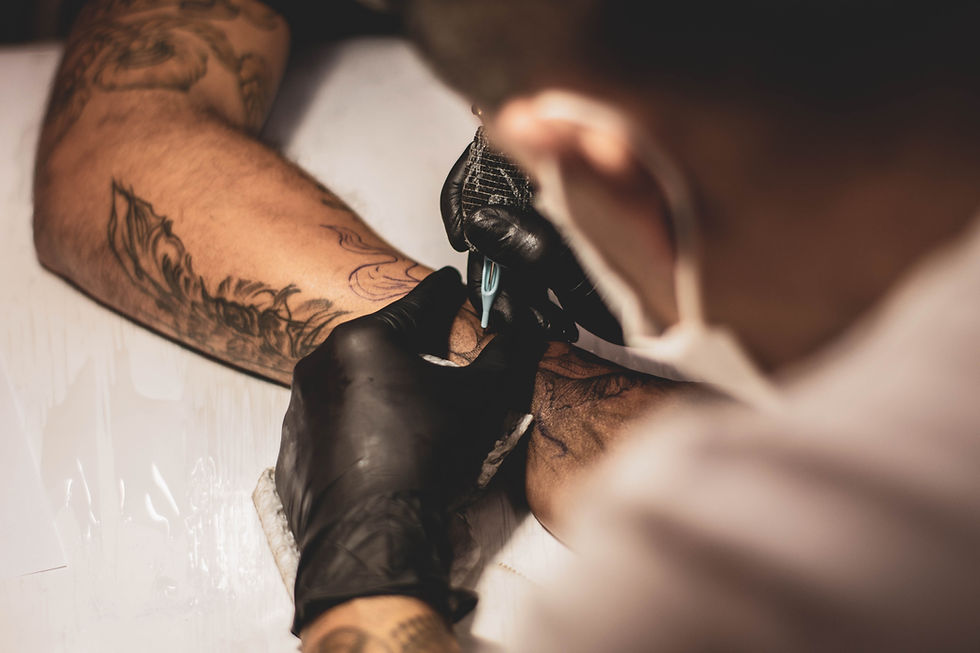Placement and Design Considerations
- Derek Benningfield
- Sep 19, 2023
- 3 min read
Updated: Nov 6, 2023
Tattoos are more than just art; they are a dynamic fusion of creativity and anatomy. The synergy between your body's unique contours and the design you choose plays a pivotal role in determining the overall aesthetic impact of your tattoo. In this comprehensive guide, we'll explore the intricate world of tattoo anatomy, delving deep into the critical factors that should influence your decisions when it comes to selecting the perfect placement and design.
1. Body Anatomy: The Canvas Matters
Understanding your body's anatomy is the first step towards achieving a harmonious tattoo. Your body is your canvas, and every canvas has its nuances:
Skin Texture: The skin's texture varies across different body areas. Some regions, like the inner forearm, feature smoother, more consistent skin, making them ideal for intricate designs. In contrast, areas with more curves, like the ribs or the inner bicep, may present a challenge for detailed work.
Curves and Contours: Consider how your body naturally curves and flows. A well-placed tattoo should complement these contours. For example, a winding vine tattoo can gracefully follow the curves of your back, accentuating your body's natural lines.
Sensitivity: Pain tolerance is a subjective matter, but it's still worth considering. Areas like the ribs, ankles, and collarbone tend to be more sensitive, so if you're concerned about pain, you might want to choose a less sensitive area for your tattoo.
2. Design Size and Complexity: Scaling Matters
The size and complexity of your chosen design should harmonize with your selected placement. Remember these essential guidelines:
Detailed vs. Simplified Designs: Smaller areas, such as the wrist or the finger, may not provide sufficient space for intricate details. If you have a design with many fine lines and tiny elements in mind, opting for a larger canvas is a smart choice.
Symmetry and Balance: Proportion matters. Consider how the design will look relative to your body size and shape. Some designs, like mandalas or geometric patterns, benefit from precise symmetry to achieve visual harmony.
3. Skin Tone and Color Choices: Aesthetic Harmony
The interplay between your skin tone and your tattoo's colors can profoundly affect the final look. Here are some aesthetic factors to keep in mind:
Contrast: Tattoos with colors that contrast with your skin tone often stand out more prominently. Vibrant colors tend to pop on lighter skin, while deeper skin tones can enhance the richness of certain hues.
Complementary Colors: Explore color theory to choose shades that not only resonate with your design's theme but also harmonize with your skin tone. Your tattoo artist can be an invaluable resource in this regard, offering guidance on color choices.
4. Personal Meaning and Symbolism: Emotional Connection
Beyond aesthetics, the emotional connection to your tattoo is paramount. The placement and design should reflect your values, beliefs, or personal experiences:
Visibility: Consider whether you want your tattoo to be a public statement or a more private, personal reminder. For instance, visible areas like the forearm or calf allow you to proudly display your ink, while concealed spots like the upper thigh or ribcage offer a more discreet option.
Emotional Resonance: The significance of your tattoo should resonate deeply with you. Whether it's a tribute to a loved one, a representation of your cultural heritage, or a symbol of a personal triumph, your tattoo's placement can enhance its emotional impact. For example, a heart tattoo over your chest can symbolize love and passion, while a family crest on your forearm can celebrate your heritage.
5. Tattoo Artist Expertise: Collaborative Creativity
Your tattoo artist is not just an ink technician; they are a collaborator in the creative process. Their expertise can make or break your tattoo:
Consultation: Don't hesitate to engage in a thorough consultation with your chosen tattoo artist. Share your ideas and expectations, and allow them to provide valuable input based on their experience. They can help you visualize how the design will interact with your body's unique anatomy.
Portfolio Review: Take the time to review your artist's portfolio to ensure they have experience with the style and design you want. Ask questions and seek their professional opinion on placement.
In conclusion, the art of tattooing transcends the boundaries of design; it's about understanding the canvas that is your body. By embracing the interplay between your body's anatomy, design size and complexity, skin tone and color choices, personal meaning and symbolism, and the expertise of your chosen tattoo artist, you can ensure that your tattoo becomes a masterpiece that seamlessly integrates with your body's natural beauty, telling your unique story for years to come.




Comments